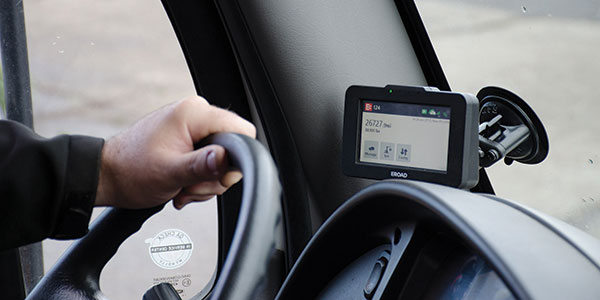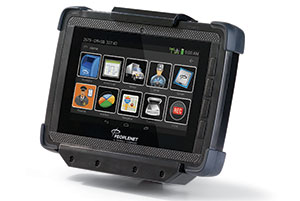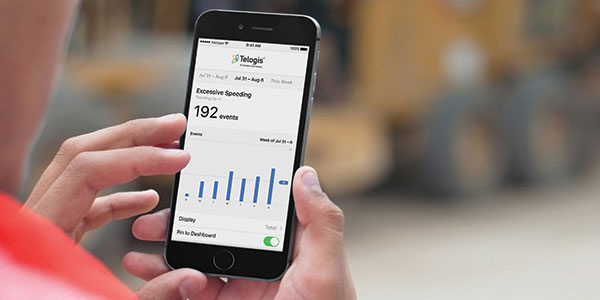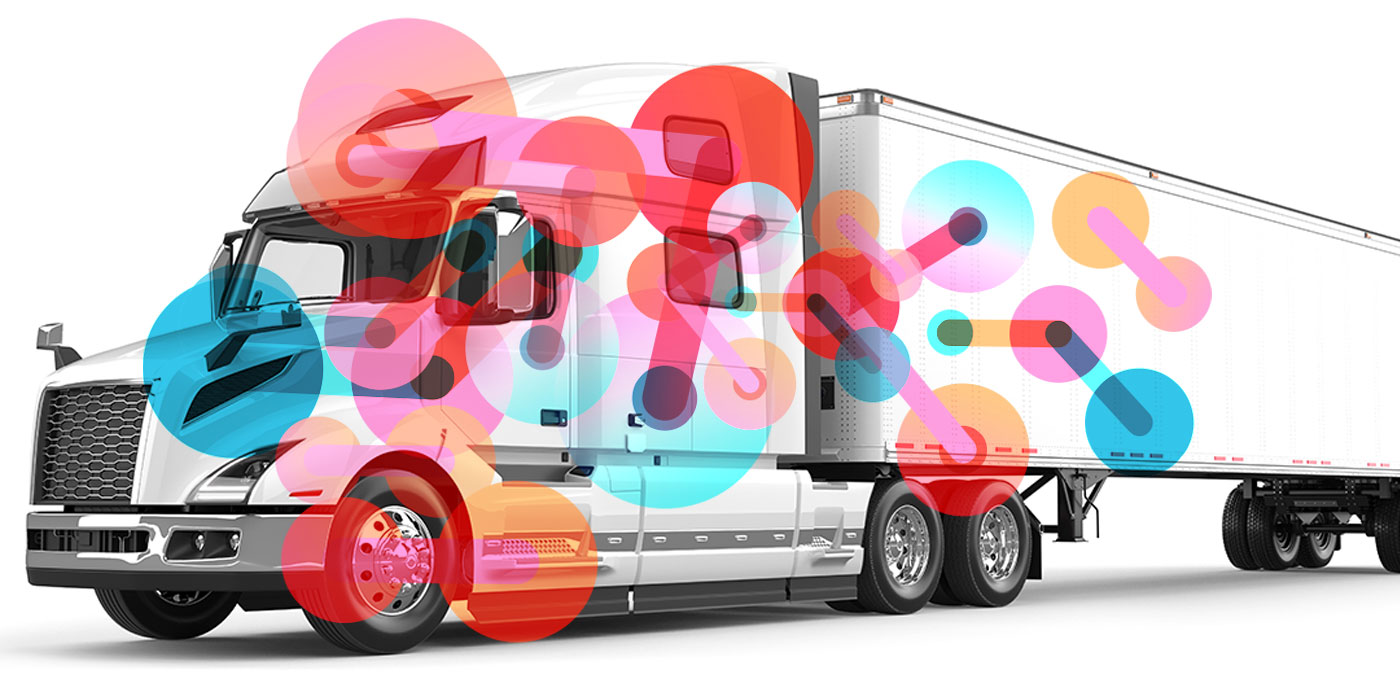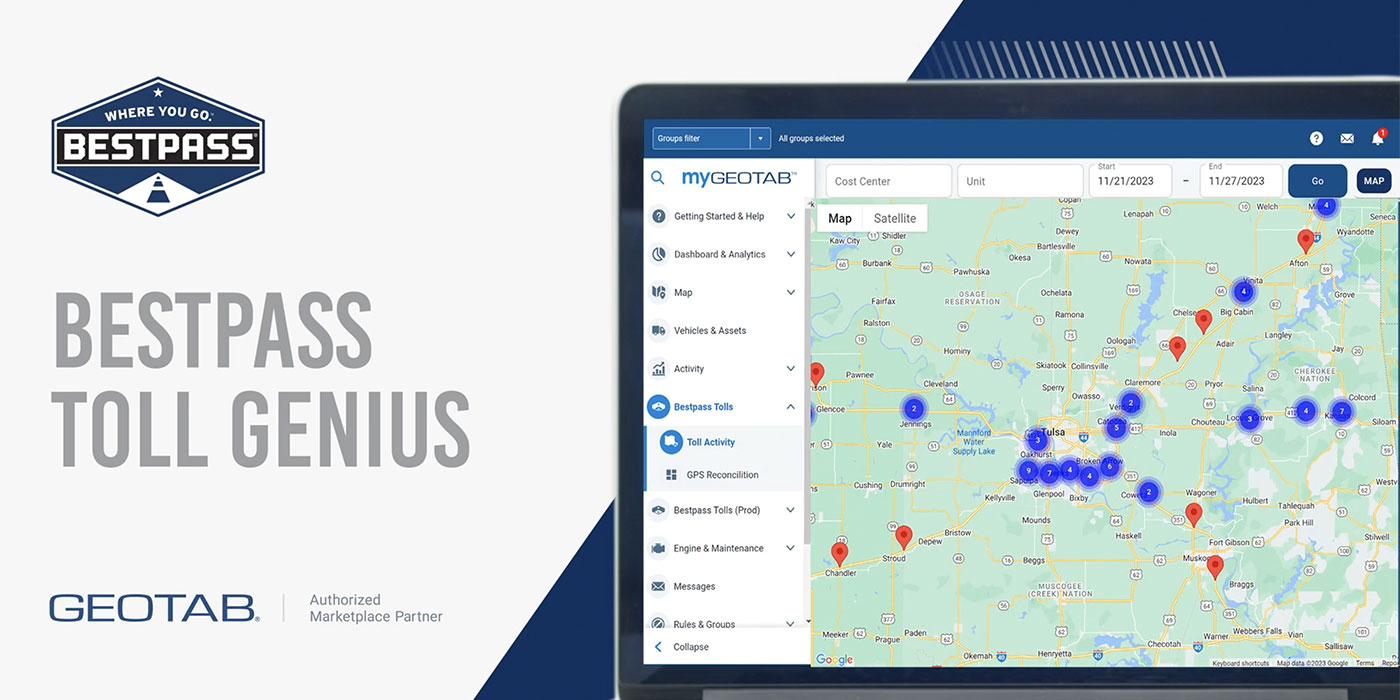According to Maria Sotra, vice president of marketing for Geotab, “Fleet managers are continuously searching for new ways to minimize operating expenses, manage total cost of ownership, and increase profitability. Geotab’s open platform fleet management solution enables businesses of all sizes to make significant improvements in the areas of safety, productivity, regulatory compliance, fleet optimization and expandability. For example, the Fleet Savings Summary Report estimates a fleet’s existing and potential cost savings based on rich telematics data.”
Using proprietary algorithms based on market and industry research, the report identifies savings in the areas of safety, fuel, maintenance, and productivity. Implementing suggested improvements can decrease a fleet’s fuel and maintenance costs by 14%, reduce accidents by 45% and result in a 5% to 25% decline in insurance costs.
“Using its SDK for developers, building and integrating new features such as advanced collision prevention systems, in-cab cameras, or in-vehicle driver coaching tools provides fleets with opportunities to improve driver behavior, ultimately increasing safety of their fleet and the roads for all,” Sotra says. “Additionally, fleets have the opportunity to spread the benefits of vehicle data throughout their entire organization. Combining vehicle data with data from CRM, maintenance software, or other systems.”
Geotab’s Marketplace consists of integration and software product partners that build and bring new features and functionality to MyGeotab, and the GO7 device. Integration partners offer IT services that use Geotab’s SDK to integrate with other internal business systems and applications, saving customers time, money, and improving the overall efficiency of their organization.
“Product partners build various apps and Add-Ins that help integrate with third-party systems like Salesforce or QuickBooks, in addition to mapping Add-Ins, dispatch, workflow automation, scheduling, routing, customer management, accounting, and many more,” says Sotra. “Geotab’s devices are compatible with all major vehicle makes and models, installing easily in your vehicle by simply plugging into your OBDII port. Depending on your vehicle, some larger commercial trucks require an additional harness also available through Geotab.”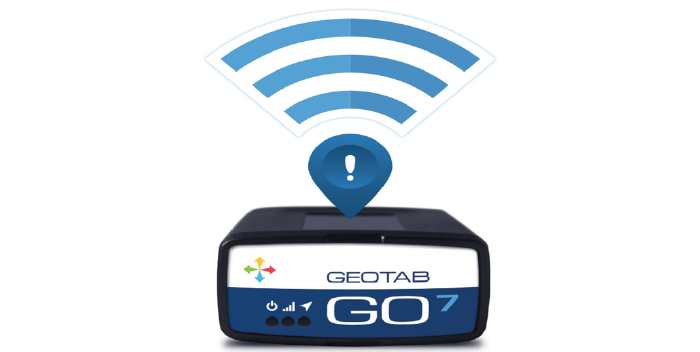
Visibility
“Running a fleet of vehicles can be costly, especially when you have no visibility into current or past vehicle or driver details,” points out Todd Ewing, director of product management for Fleetmatics. “By knowing each vehicle’s location, you’re able to more easily identify the best routes, which leads to improved dispatching efficiency, lower fuel costs, less mileage and less damaging wear and tear. Fleet tracking also provides insight into driver behavior and allows you to more closely monitor driver safety.”
The reality today is that most businesses are full of systems to manage data and report on drivers, vehicles and teams. “A vehicle intelligence solution that provides access to these applications can help to ensure that these systems remain in sync while decreasing the time required to do so,” Ewing says. “Fleetmatics Reveal offers an API that includes tools and support needed to help small and medium businesses share valuable information between Fleetmatics Reveal and other systems. It results in synchronized systems that require less administration and provide complete picture reporting and ultimately, fully realized value across fleet and back office systems.
“Fleetmatics kicks off the user journey by offering training at no charge, so new users have a clear picture of Fleetmatics Reveal capabilities and an understanding of how to put those features to work before they ever even log into the application. A trained Fleetmatics employee conducts training. Fleetmatics is built with the small or medium-sized business owner in mind. The software is developed to be easy to use and to adapt to the challenges that these companies face, making them more agile, efficient and able to deliver customer service fleets expect.”
Effective management
“A great way to manage fleet costs,” recommends Eric Witty, vice president of product management for PeopleNet, “is through implementation of onboard technology. It comes down to purchasing the right technology and utilizing its capabilities to get the greatest return on investment. For example, fleets can utilize our system’s applications to: electronically monitor fleet performance and receive real-time diagnostics; gain insight into driver performance and behavior; and track hours of service (HOS) to ensure compliance with new electronic logging device (ELD) regulations.”
With the ELD compliance date quickly approaching in December 2017, there is an increased focus on fleet safety and compliance in the industry. “There will continue to be more competition and confusion in the marketplace,” says Witty, “but fleets must employ due diligence to make sure they purchase the right system from a reputable vendor—who has longevity in the marketplace—otherwise, it may end up costing them more money in the long-run.”
The ELD Mandate also presents an opportunity for fleets to address other key areas of their business. “Going beyond just an ELD and selecting a more robust Fleet Management System (FMS) can provide additional capabilities like onboard event recording, speed monitoring, IFTA reporting and comprehensive dashboards and analytics reports,” Witty says. “This technology gives fleets not only the ability to electronically log HOS, but to also improve how they do business and help to generate a greater return on investment.”
PeopleNet has the ability to integrate with both mobile devices and back office systems. “The mobile integration piece is significant because it allows us to run third-party applications on our system, which provides us with more data and also helps to enrich outside applications that customers use,” says Witty. “For example, our sister company ALK runs its navigation application on the PeopleNet system to provide drivers with the most accurate directions, improve vehicle efficiency and decrease out-of-route miles. We have at least a dozen partners that connect to the PeopleNet mobile platform to share data.”
Efficiency, safety and productivity
“We talk about focusing on E.S.P.—efficiency, safety and productivity—as the key focus areas to run a more cost-effective company, using onboard telematics solutions, or what we refer to as mobile resource management (MRM) software,” relates Kelly Frey, vice president of product marketing for Telogis Inc. “Efficiency is all about operational cost reduction, with savings of 5-20% being very achievable by reducing unnecessary fuel and labor costs related to inefficient driving and poorly optimized routing. Safety is one of the fastest ways to get a bigger bang for the buck, because there is a direct correlation between driving safely and driving cost-effectively. The fewer jackrabbit starts, speeding and hard-braking across a fleet, the lower the operational costs will be, including fuel, maintenance, damage and insurance costs. It is not unusual to see a more than 90% reduction in unsafe driving behaviors, resulting in a five to 15% reduction in avoidable operating costs.
“Productivity relates to doing more work and generating more revenue by focusing on fleet and labor productivity, but with fewer vehicles and labor,” he continues. “We typically expect a five to 30% improvement in return on invested labor and capital by leveraging onboard telematics and workforce optimization applications.”
“System integration with other fleet software takes our solution’s value well beyond simply connecting and reporting of vehicle location and health and driving performance, to optimization and automation of fleet operations, workflow and cash flow processes,” Frey adds. “Helping companies with fleets and lots of mobile employees dramatically improve customer satisfaction, reduce account churn and drive more revenue as a result of onboard telematics and mobile resource management is much more valuable than driving out costs alone.”
“We look at the telematics as a starting point,” Frey says. “Much more business value can be achieved by leveraging the connectivity and resultant telematics data to empower the optimization and automation of crucial business and cash flow processes that create competitive differentiation and business transformation. We typically look at a three to five year time horizon during our ‘ideation’ and quarterly business review (QBR) sessions with our clients to determine how best to apply the technologies we provide with clients business capabilities and objectives.”
Flexibility and configurability are critical in today’s rapidly changing business environment, so it is important that fleets choose a telematics provider with a full platform that is flexible enough to satisfy their needs today, but also well into the future. The provider should be able to provide connectivity on one platform for all types of on-road vehicles, off-road vehicles and equipment, as well as mobile workers and the mobile devices that they may be carrying or need mounted in the vehicles. They should also look at a provider that has a full suite of route and schedule planning/dispatch capabilities, as well as commercial navigation and mobile compliance applications that can keep their drivers safe, compliant, efficient and productive.
Adding control
Gail Levario, vice president of strategy and market development for EROAD, notes that some of the most cost effective telematics solutions are related to controlling fuel consumption, compliance, safety, driver happiness, record-keeping obligations and overall operating costs are all major factors fleet managers face on a daily basis. “Having a single telematics solution that addresses all these (and more) is key,” she adds. Before selecting a telematics solution make sure it’s a product that can grow and conform to not only your needs but the ever-changing regulatory needs as well.”
In addition to ensuring your telematics solution will meet upcoming ELD requirements. “It needs to provide accurate and auditable distance reporting for IFTA requirements,” Levario adds. “Not only will this keep you compliant with recording-keeping responsibilities, but also it will help identify exempt miles and avoid payment of excess highway use taxes. That alone can be a huge annual savings.”
Fuel management, not only by the driver but also by management as well is another very effective cost management tool. “Providing drivers with real-time feedback, effective training and reward programs assists in creating better drivers and better drivers are safer, use less fuel, incur lower maintenance costs and improve CSA scores and insurance costs,” Levario says.
“Designed from the ground up to meet the highest performance, financial and evidentiary standards, EROAD provides an open, standards-based interface using the REST architecture and provides an easy and intuitive way of communication with EROAD via the HTTP protocol,” Levario says. “Benefits allow customers to: integrate EROAD tracking into proprietary tracking/dispatch system by continuously polling for current location; integrate EROAD distance readings into proprietary maintenance or lease module by query daily/weekly. In addition, it connects back-end asset management systems maintain vehicle information avoiding unnecessary manual effort.”
Defining telematics
“We define telematics as the use of wireless technology to transmit data from [commercial] vehicles to their dispatch and management organizations,” says Jeff Champa, vice president of product management for Omnitracs. “These are aftermarket devices or bring your own device (BYOD), i.e., tablets and smartphones, SaaS solutions that transmit data on vehicle location, and maintenance and event notification [braking, idling, speed].”
“There are so many ways to use telematics systems to extract value that it is difficult to boil it down to something less than an entire book,” says Jim Gardner, vice president of marketing for Omnitracs. “It really depends on what kind of fleet you are and what your business is, as well as how you set priorities, the equipment you run, etc. We break our product portfolio into five product themes: compliance, efficiency and productivity, safety and security, vehicle life cycle management and driver satisfaction. Each product theme has its own suite of value plays capable of justifying the entire system investment.”
For compliance, Gardner says, the core applications are HOS and DVIR. These solutions reduce physical paperwork, prevent errors, speed communication of information, allow for better planning, and, most importantly, help keep drivers and fleets complaint with regulations. There are also solutions such as Weigh Station Bypass and IFTA Reporting that can grant drivers bypass to inspection sites and support filing your IFTA taxes respectively.
Efficiency and productivity includes routing and planning, navigation, data analytics among others. “These solutions are deep in capability and each offer further value with specific features and functions,” Champa says. “For example, navigation obviously helps drivers get from one location to the next on a truck compliant route. If you dig deeper, there is much more value those just turn-by-turn directions. Incorporating a fleet prescribed planning process that accounts for driver needs appropriately and then measuring adherence to the plan in real time provides additional value by minimizing out of route miles. Likewise, usage of historic and real-time traffic information and real-time weather and road conditions can plan the safest and most efficient routes for drivers. And further, analyzing fleet progress in real-time and adjusting future plans to continuously optimize the usage of the fleet is just one more area of benefit.”
Safety and security is paramount for every fleet on the road. “All fleets and drivers want to be safe,” Gardner says. “Omnitracs provides a numbers of solutions targeted at the driver and the fleet to help keep their operations safe. Tracking, measuring and managing critical events coming from a vehicle helps a fleet understand vehicle usage which in turn leads to awareness for the fleet and the driver which allows for constructive coaching to keep both on target with the fleet’s safety objectives. Let’s face it: our industry’s drivers are the safest on the road statistically, but they often seem to get bad PR.”
“The addition of cameras into the vehicle can quickly prevent unwarranted litigation looking for someone to blame,” he continues. “On the security front, drivers are the face of a fleet and their most valuable asset. Placing driver security first is a must, especially in some international markets. Omnitracs has a whole suite of solutions to keep drivers, trucks and cargo safe.”
Visibility and control
It’s one thing to have telematics; it’s another to have visibility and control of your fleet operations, as well as access to real-time data from any internet-enabled device through a secure web-based application. “If you can map every turn of the key, every stop and all other activities of a vehicle, then you can make informed decisions to improve operational efficiencies and reduce costs,” says Kurt Nantkes, senior vice president at Zonar.
A proper telematics solution can pay for itself by allowing fleet mangers to easily supervise driver speeds, path, safety and idling. When those things are done right, your vehicle will end up with more uptime via fewer compliance issues, increased fuel savings, and better compliance, plus the reduction of greenhouse gases.
“With the right telematics solutions,” Nantkes continues, “you can have data at your hands to identify exactly what each vehicle was doing and at what time. For example, if there is a claim that a driver was operating a vehicle too fast or idling for an extended period, the data from your telematics solutions should be able to tell if that was the case. This makes drivers accountable and provides them with transparent data to confront false claims.
“Fuel efficiency is an additional component of telematics solutions like Zonar Ground Traffic Control, which includes our ZFuel application, which provides driver and truck analysis tools for improving truck operation and performance.
“Through our open API and easily-customizable platform, Ground Traffic Control allows Zonar customers to integrate with other systems allowing fleets to have a single platform instead of multiple, disconnected technology solutions,” he explains. “The primary benefit is providing drivers and fleet managers a one-stop-shop where they can access the robust functionality of Ground Traffic Control as well as compatible solutions from other providers, including maintenance software, navigation, route planning, video surveillance, weigh station bypass, construction management, workforce management, safety and compliance, geospatial mapping, and transportation management. Zonar takes time to understand each client’s business. Rather than having a one-size-fits-all approach, we create a solution that is specific to each organization’s needs and work with them to evolve their approach as technology and the industry change.”
Handling fleet managers’ burdens
According to Teletrac Navman, fleet managers face pressing questions on a daily basis that impact their entire business, so the easier they can interpret a fleet’s data, the faster they can course correct. By managing assets and vehicles from a single telematics platform, managers can reduce the administrative burden of managing multiple systems, and can benefit from instant data analysis—maximizing asset usage to increase productivity and maintain preventive care of vehicles. Such data visibility allows them to continuously improve day-to-day, or even minute-to-minute, decisions that keep costs down.
With onboard telematics, fleet managers know exactly where their trucks are, cut waste and improve overall situational awareness, as well as increase route optimization and driver utilization. Time is no longer wasted looking for and waiting on vehicles. An in-vehicle solution provides data that would otherwise go unseen, delivering critical insight into driver behavior, fuel management and equipment diagnostics. Additionally, with compliance digitally tracked, paper-based logs and other manual processes are limited, reducing the risk of costly fines, improving vehicle maintenance and ensuring greater uptime.
Fleets have experienced an increased need to connect disparate technologies and relieve administrative duties, seeking a streamlined workflow between the field and the back office. Teletrac Navman integrates with software partners, like Command Alkon, ProMiles and McLeod, to offer customers a powerful platform to track fleet activities and reduce the risk of audits and compliance violations—all within a single view, the company says. Teletrac Navman’s Director breaks down the silos between drivers and dispatchers, compiling data from third-party platforms to offer a complete picture of a fleet’s workflow – starting with the original customer order, through driver dispatch and proof of delivery. According to Teletrac Navman, Director provides an API library to integrate with all types of software, creating an automated end-to-end workflow.

